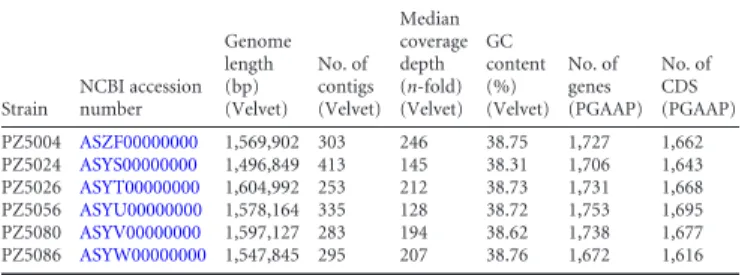Draft Genome Sequences of Helicobacter pylori Strains Isolated
from Regions of Low and High Gastric Cancer Risk in Colombia
The MIT Faculty has made this article openly available.
Please share
how this access benefits you. Your story matters.
Citation
Sheh, A., M. B. Piazuelo, K. T. Wilson, P. Correa, and J. G. Fox. “Draft
Genome Sequences of Helicobacter Pylori Strains Isolated from
Regions of Low and High Gastric Cancer Risk in Colombia.” Genome
Announcements 1, no. 5 (August 29, 2013): e00736–13–e00736–13.
As Published
http://dx.doi.org/10.1128/genomeA.00736-13
Publisher
American Society for Microbiology
Version
Final published version
Citable link
http://hdl.handle.net/1721.1/89169
Terms of Use
Creative Commons Attribution 3.0
Draft Genome Sequences of Helicobacter pylori Strains Isolated from
Regions of Low and High Gastric Cancer Risk in Colombia
Alexander Sheh,aM. Blanca Piazuelo,bKeith T. Wilson,b,c,d,ePelayo Correa,bJames G. Foxa,f
Division of Comparative Medicine, Massachusetts Institute of Technology, Cambridge, Massachusetts, USAa; Division of Gastroenterology, Department of Medicine,
Vanderbilt University School of Medicine, Nashville, Tennessee, USAb; Department of Cancer Biology, Vanderbilt University School of Medicine, Nashville, Tennessee, USAc;
Department of Pathology, Microbiology and Immunology, Vanderbilt University School of Medicine, Nashville, Tennessee, USAd; Veterans Affairs Tennessee Valley
Healthcare System, Nashville, Tennessee, USAe; Department of Biological Engineering, Massachusetts Institute of Technology, Cambridge, Massachusetts, USAf The draft genome sequences of six Colombian Helicobacter pylori strains are presented. These strains were isolated from pa-tients from regions of high and low gastric cancer risk in Colombia and were characterized by multilocus sequence typing. The data provide insights into differences between H. pylori strains of different phylogeographic origins.
Received 15 August 2013 Accepted 21 August 2013 Published 19 September 2013
Citation Sheh A, Piazuelo MB, Wilson KT, Correa P, Fox JG. 2013. Draft genome sequences of Helicobacter pylori strains isolated from regions of low and high gastric cancer risk
in Colombia. Genome Announc. 1(5):e00736-13. doi:10.1128/genomeA.00736-13.
Copyright © 2013 Sheh et al. This is an open-access article distributed under the terms of theCreative Commons Attribution 3.0 Unported license. Address correspondence to James G. Fox, jgfox@mit.edu.
H
elicobacter pylori is a Gram-negative, microaerophilic,helix-shaped bacterium that colonizes the stomachs of at least half of the world’s human population (1). In most cases, H. pylori can persist in the human stomach without health consequences, though it is a risk factor for chronic gastritis, gastric or duodenal ulcers, and gastric cancer (2).
In the present report, we announce the genome sequencing of six strains of Helicobacter pylori. These strains were isolated from three patients from the low-gastric-cancer-risk region of Tumaco, Colombia (strains PZ5004, PZ5024, and PZ5026), and three pa-tients from the high-gastric-cancer-risk region of Pasto, Colombia (strains PZ5056, PZ5080, and PZ5086). These strains have been previously classified by multilocus sequence typing (MLST) and found to be of African (PZ5004 and PZ5024) and of European (PZ5026, PZ5056, PZ5080, and PZ5086) origins (3). Microarray analysis of these six strains demonstrated that clustering of tran-scriptomes also sorted strains based on their phylogeographic or-igins, with greater expression of virulence genes, such as cagA and
vacA, in European strains (4). European strains also induced greater interleukin 8 (IL-8) expression while reducing apoptosis (4). The genome data provide insights about the genomic diversity of H. pylori from two sites with different incidence risks for gastric cancer and may help determine the underlying causes for differ-ential transcription and virulence. The RNase-treated DNAs from the six isolates were sequenced using an Illumina MiSeq system as described previously (4). The 150-bp paired-end sequencing reads generated by MiSeq were assembled into contigs using Velvet (5). Sequences were annotated using the NCBI Prokaryotic Genomes Automatic Annotation Pipeline (PGAAP) (6). Pertinent statistics are summarized in Table 1. Overall, average GC contents of 38.65% and 1,660 coding DNA sequences (CDS) were found. The median coverage depth ranged from 128- to 246-fold.
Nucleotide sequence accession numbers. The genome
se-quences of Helicobacter pylori strains PZ5004, PZ5024, PZ5026,
PZ5056, PZ5080, and PZ5086 were deposited at GenBank with the accession numbers listed inTable 1.
ACKNOWLEDGMENTS
This work was supported by National Institutes of Health grants P01CA028842 (to J.G.F., K.T.W., and P.C.), P01CA026731 (to J.G.F.), and P30ES002109 (to J.G.F.).
REFERENCES
1. Kusters JG, van Vliet AH, Kuipers EJ. 2006. Pathogenesis of Helicobacter
pylori infection. Clin. Microbiol. Rev. 19:449 – 490.
2. Fox JG, Wang TC. 2007. Inflammation, atrophy, and gastric cancer. J. Clin. Invest. 117:60 – 69.
3. de Sablet T, Piazuelo MB, Shaffer CL, Schneider BG, Asim M,
Chatur-vedi R, Bravo LE, Sicinschi LA, Delgado AG, Mera RM, Israel DA, Romero-Gallo J, Peek RM, Jr, Cover TL, Correa P, Wilson KT. 2011.
Phylogeographic origin of Helicobacter pylori is a determinant of gastric cancer risk. Gut 60:1189 –1195.
4. Sheh A, Chaturvedi R, Merrell DS, Correa P, Wilson KT, Fox JG. 2013. Phylogeographic origin of Helicobacter pylori determines host-adaptive re-sponses upon coculture with gastric epithelial cells. Infect. Immun. 81: 2468 –2477.
5. Zerbino DR, Birney E. 2008. Velvet: algorithms for de novo short read assembly using de Bruijn graphs. Genome Res. 18:821– 829.
6. Klimke W, Agarwala R, Badretdin A, Chetvernin S, Ciufo S, Fedorov B,
Kiryutin B, O’Neill K, Resch W, Resenchuk S, Schafer S, Tolstoy I, Tatusova T. 2009. The National Center for Biotechnology Information’s
Protein Clusters Database. Nucleic Acids Res. 37:D216 –D223.
TABLE 1 Pertinent statistics for sequenced Colombian strains
Strain NCBI accession number Genome length (bp) (Velvet) No. of contigs (Velvet) Median coverage depth (n-fold) (Velvet) GC content (%) (Velvet) No. of genes (PGAAP) No. of CDS (PGAAP) PZ5004 ASZF00000000 1,569,902 303 246 38.75 1,727 1,662 PZ5024 ASYS00000000 1,496,849 413 145 38.31 1,706 1,643 PZ5026 ASYT00000000 1,604,992 253 212 38.73 1,731 1,668 PZ5056 ASYU00000000 1,578,164 335 128 38.72 1,753 1,695 PZ5080 ASYV00000000 1,597,127 283 194 38.62 1,738 1,677 PZ5086 ASYW00000000 1,547,845 295 207 38.76 1,672 1,616 Genome Announcements
